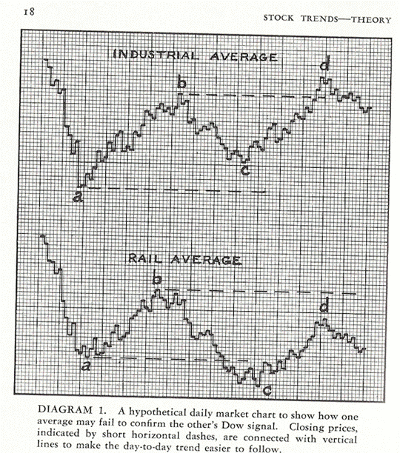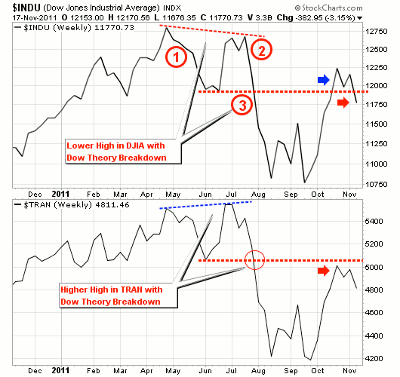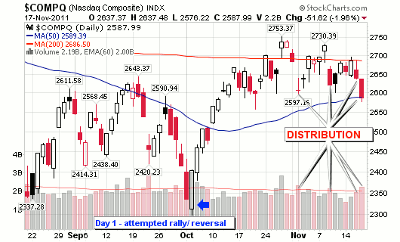Failure of the Dow Transports to confirm the recent action seen in the Industrials is a sign that there has not been a real change in the market’s overall trend and caution is the best course of action now.
The correct determination of the direction of the primary trend is the most important factor in successful speculation (trading and investing). The primary trend (also referred to as movement) is the broad basic trend generally known as a bull or bear market lasting a period of time from less than a year to several years. The primary trend is the most important of the three movements discussed within The Dow Theory.
The Dow Theory also includes movements such as the secondary reaction and the daily fluctuations. I am not interested in daily action because these short-term movements are typically unimportant.
See related: Elliott Wave vs. Dow Theory
Edwards and Magee said:
“The Dow Theory is the granddaddy of all technical market studies” and “It is built upon and concerned with nothing but the action of the stock market itself (as expressed in certain “averages”), deriving nothing from the business statistics on which the fundamentalists depend.”
The purpose of this post is to highlight the Principle of Confirmation, which states that the two averages must confirm. The authors note that this principle has often been questioned and is the most difficult to rationalize of all the principles, yet it has stood the test of time.
They go on to say:
“…the fact that it has “worked” is not disputed by any who have carefully examined the records. Those who have disregarded it in practice have, more often than not, had occasion to regret their apostasy”.
Please repeat the following rule several times and learn it, understand it, and trade by it:
“What it means is that no valid signal of a change in trend can be produced by the action of one average alone.”
Here is a chart from the fourth edition of their book, Technical Analysis of Stock Trends, published in 1957.
NEXT: Latest Charts of Dow Industrials, Dow Transports
|pagebreak|Now take a look at a weekly chart of the Dow Jones and Transports. Do you see any similarities?
Of course you do. The Transports have not confirmed the change in trend along with the Dow. In fact, the Dow is now back below the resistance line after this week’s negative action.
Many traders on StockTwits, Twitter, blogs, and TV (if you still watch financial television) are miffed about the action of the market over the past several weeks, and particularly the past week. Well, the trend hasn’t confirmed, so the risk is still high that the so-called “leaders” are setting up for failure or head fakes.
I’ve started to sound like a broken record with my Dow Theory tweets, but if it is fact, it is fact. As traders, we must be patient and wait for the confirmation before loading up on new shares. A trend change may still occur, but we must cast a shadow of doubt until both averages confirm.
If you don’t want to listen to me, a lowly stock blogger, at least listen to what Robert Rhea said in 1932:
“The movement of both the railroad and industrial stock averages should always be considered together. The movement of one price average must be confirmed by the other before reliable inferences may be drawn. Conclusions based upon the movement of one average, unconfirmed by the other, are almost certain to prove misleading.”
Please note that “railroads” have been replaced with “transports” in today’s world.
Trading can essentially be broken down to managing risk, and as Victor Sperandeo stated, “market forecasting is a matter of probabilities; the risk of being wrong is always present.”
So why tilt the risk against you if history shows us that both averages must confirm for a sustainable change of trend to take place? It’s a wacky world out there, but the rules haven’t changed, so wait for the confirmation before jumping in with both feet.
Market observation from Thursday, November 17, 2011: The Nasdaq has now flashed four distribution days since the start of the month. This is a red flag and a signal to lock in profits and sell losing positions before they grow in size.
By Chris Perruna, trader and blogger, ChrisPerruna.com
























